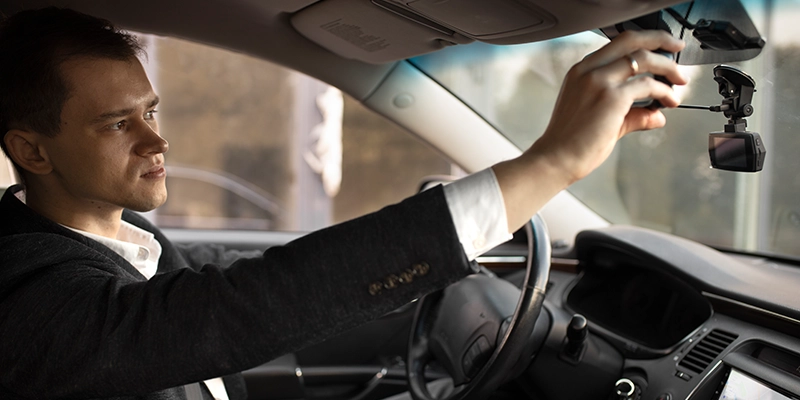Contents
The rise of dashcams is changing the landscape of personal injury law. Once considered niche, these devices are now becoming standard equipment for many drivers. Their ability to provide real-time video evidence by capturing the events leading up to, during, and after an accident provides critical evidence that can influence liability decisions.
TL;DR
Dashcam footage has become a pivotal tool in personal injury cases, providing a reliable, impartial, and persuasive means of establishing liability and substantiating claims. Its capacity to document events in real time lends significant clarity and value, often shaping the outcome of settlement negotiations and judicial determinations. Following best practices in collecting, preserving, and presenting the evidence is crucial to ensuring its full legal impact. Proper chain of custody, maintaining the footage’s authenticity, and securing its integrity are critical steps in leveraging the full legal potential of dashcam recordings.
To maximize the value of Accident video in personal injury cases, ensure it’s collected legally, preserved with proper chain-of-custody protocols, and presented strategically with clear playback and key moments highlighted to enhance its impact in negotiations and court.
I. The Value of Dashcam Footage
A. Providing Unbiased Evidence
Dashcam footage offers an unfiltered, real-time record of events, making it one of the most reliable forms of evidence in personal injury cases. Unlike witness testimony, which can be influenced by memory lapses or personal bias, dashcam recordings present an objective view of what happened. This can include details like the speed of the vehicles, traffic conditions, and driver behavior leading up to the incident.
B. Supporting or Refuting Claims
Dashcam recordings can substantiate a driver’s version of events or challenge false claims. For instance, in accidents where the fault is disputed, the footage can clarify whether a driver ran a red light, made a sudden stop, or followed traffic rules. By providing clear, factual evidence, accident videos strengthen legitimate claims while discouraging fraudulent ones.
Accident video can also enhance the trustworthiness of a client’s claims. It provides visual proof that lawyers can present to insurance companies, opposing counsel, or even a jury, making the evidence more compelling and harder to dispute.
C. Accelerating Case Resolution
One of the most significant advantages of using accident video is its ability to expedite case resolution. Disputes over liability often drag out personal injury cases, but a clear recording of the incident can simplify these arguments. With concrete evidence, insurance adjusters are more willing to negotiate fair settlements early. Opposing counsel may find it harder to contest liability, which can mean a shorter litigation time, reducing the need for prolonged litigation. This benefits clients by providing quicker resolutions and allows law firms to handle more cases efficiently.
II. Legal Considerations for Dashcam Footage Use
A. Admissibility in Court
Accident video must meet certain standards to be admissible. Courts typically evaluate whether the footage is relevant, authentic, and unaltered. Drivers should ensure their recordings are timestamped and stored securely to maintain their integrity; it’s essential to preserve the dashcam’s original files and ensure proper chain-of-custody procedures. In some cases, technical details like image clarity and continuity can also impact admissibility. Proper handling of the footage can make the difference between it being accepted or dismissed as evidence.
Courts typically require that the person presenting the footage (the driver or their legal representative) testifies about how it was recorded and stored. Reliable storage solutions, like RunSensible’s cloud-based system, can help ensure your video evidence is safely preserved and easily accessible when needed. RunSensible simplifies evidence management with secure uploads and tamper-proof storage, protecting your footage’s integrity and admissibility.
B. Privacy and Consent Laws
Dashcams can record more than just the Accident. Accident video might capture pedestrians, bystanders, or conversations inside the vehicle that may violate privacy laws. This raises important privacy and consent issues, which vary significantly depending on the jurisdiction. Many regions mandate one-party or two-party consent, especially for audio recordings; this means audio portions of the footage could be inadmissible or even lead to legal consequences for the recorder. Lawyers must carefully evaluate the content of the recording and its legality before presenting it as evidence.
C. State and Federal Regulations
Dashcam use is regulated differently across states and countries, for instance:
• Mounting Rules: Provinces like Ontario and British Columbia have guidelines regarding the placement of dashcams. In accordance with road safety regulations, devices must not obstruct the driver’s view or interfere with vehicle operation.
• Privacy Legislation: Federal laws like the Personal Information Protection and Electronic Documents Act (PIPEDA) and provincial laws like Alberta’s Personal Information Protection Act (PIPA) govern the collection, use, and disclosure of personal information. Dashcams that capture identifiable individuals in public or private spaces may fall under these regulations, particularly when the footage is used in legal proceedings.
• Audio Recording: Similar to U.S. laws, recording conversations in Canada may violate privacy laws if consent from all parties isn’t obtained. Lawyers must carefully evaluate whether audio portions of dashcam footage comply with applicable consent requirements.
Understanding these laws is crucial for ensuring that accident videos are admissible and legally obtained. Legal professionals must stay updated on evolving regulations to advise clients appropriately and avoid jeopardizing a case due to non-compliance.
III. Best Practices for Managing Dashcam Evidence
A. Collecting Footage Legally
When using dashcam footage in personal injury cases, it is crucial to ensure that the footage is obtained in compliance with all relevant laws. This involves adhering to privacy regulations, meeting consent requirements, and following rules regarding dashcam placement. Collecting footage legally helps drivers avoid complications that could jeopardize their admissibility in court.
B. Preserving the Integrity of the Footage
Preserving dashcam footage’s integrity is critical to ensuring it remains credible and admissible in court. The original recording must remain unaltered, as any signs of tampering can call its authenticity into question. This means avoiding edits, enhancements, or any changes to the file.
Establishing a transparent chain of custody is another key step. The chain of custody documents every person or entity that has handled the footage, demonstrating that it has been stored securely and handled appropriately. Using digital tools to verify the metadata, For example, timestamps or GPS data embedded in the video can further support its reliability.
C. Presenting Footage Effectively
Presenting dashcam footage in court requires a strategic approach to make the evidence as impactful as possible. Clear, high-quality visuals are essential, so legal teams should ensure the playback equipment used in court accurately displays the footage.
Attorneys should guide juries or judges through the video by highlighting critical moments and connecting the footage to the legal arguments of the case. Using annotations, timestamps, or brief explanations can help clarify key events without overwhelming the audience with unnecessary details.
IV. Overcoming Challenges with Dashcam Evidence
A. Technical Issues
Low-quality or incomplete footage can diminish the usefulness of accident videos in personal injury cases. Grainy Video, obstructed views, or missing timestamps can all reduce the evidentiary value of dashcam recordings. Consider investing in a high-quality dashcam with HD recording and wide-angle lenses to mitigate these issues. Regularly maintain the device and make sure the memory card has sufficient space. To mitigate these issues, legal professionals should work with forensic video experts to enhance clarity and extract usable information. They can also combine dashcam footage with other evidence, like photographs, police reports, or witness statements, to build a complete picture of events.
B. Opposing Counsel Objections
Opposing counsel often scrutinizes dashcam footage and may argue against its admissibility. Common objections include claims of tampering, irrelevance, or violation of privacy laws. To counter these challenges, ensure the footage is collected legally and remains unaltered. Establishing a transparent chain of custody and having technical experts verify the authenticity of the footage can strengthen its credibility. Preparing to address privacy concerns or contextual misunderstandings in court can also preempt potential objections.
C. Ethical Considerations
Ethical concerns about using accident videos often revolve around manipulation or misrepresentation. Editing footage, taking moments out of context, or emphasizing certain elements to skew the narrative could undermine the lawyer’s credibility and harm the case.
To avoid these pitfalls, attorneys should present footage in its unaltered state, using only legally permissible enhancements to improve clarity without altering the content. It’s also important to disclose the footage promptly to opposing counsel as part of discovery obligations.
V. Collaborating with Experts
A. Forensic Video Analysts
Forensic video analysts play a crucial role in enhancing and authenticating dashcam footage for use in personal injury cases. These professionals can improve the clarity of footage, ensuring key details like license plates, traffic signals, or vehicle movements are visible. They can also verify the video’s authenticity by analyzing metadata and confirming it hasn’t been tampered with.
Their expertise is valuable when dealing with grainy, dark, or difficult-to-interpret footage. Analysts can provide reports and testimony to validate the footage, bolstering its admissibility and credibility in court. Collaborating with a forensic video analyst ensures that the evidence presented is reliable and compelling.
B. Legal Technology Specialists
Legal technology specialists assist attorneys in integrating dashcam footage into their case presentations. Whether in settlement discussions or courtroom trials, these experts ensure the footage is displayed effectively, using tools that highlight crucial aspects of the video.
For example, they can create annotated versions of the footage, add timestamps, or synchronize the video with other evidence like accident reconstruction diagrams. By making the footage easier for judges, juries, and opposing counsel to understand, legal technology specialists help attorneys maximize its impact.
VI. Impact on Case Strategy
A. Influencing Settlement Negotiations
One of the most significant impacts of dashcam footage is its ability to expedite and influence settlement discussions. Strong, irrefutable evidence can pressure opposing parties to agree to fair settlements, avoiding lengthy trials. For example, a clear traffic violation or accident sequence recording can establish fault early, leaving little room for dispute. Legal teams can use this advantage to negotiate better client outcomes, saving time and reducing legal expenses for all parties involved.
B. Shaping Jury Perception
Dashcam footage can be a powerful tool to sway jury perception. Unlike written testimony or verbal accounts, visual evidence is immediate and impactful. It allows jurors to see the events themselves, creating a stronger emotional connection to the case.
When presented effectively, dashcam footage can clarify complex accident scenarios and counter opposing arguments. For example, it can dispel misconceptions or inaccuracies in a defendant’s testimony, making the plaintiff’s case more credible. Attorneys who use this evidence strategically—focusing on the most compelling moments and explaining their significance—can use it to leave a lasting impression on the jury.
VII. With RunSensible, Manage Digital Evidence Easier and More Efficiently
Dashcam footage can be a game-changer in personal injury cases, but managing it effectively is critical. RunSensible’s legal case management software offers powerful tools to help law firms handle digital evidence like dashcam footage efficiently and securely.
A. Secure Storage Solutions
RunSensible provides secure cloud storage options, protecting valuable dashcam footage from accidental loss or tampering. The platform allows law firms to organize and store digital evidence systematically, making it easy to locate and retrieve files when needed. Advanced encryption safeguards sensitive data, giving attorneys and clients peace of mind.
B. Easy File Sharing
With RunSensible’s file-sharing features, collaborating with team members and experts is simple. You can securely share dashcam footage with forensic video analysts, legal technology specialists, or opposing counsel while maintaining full control over access permissions. This streamlined process saves time and keeps the focus on building a strong case.
C. Integration with Case Files
RunSensible’s software enables seamless integration of dashcam footage with relevant case files. By linking evidence directly to individual cases, attorneys can quickly reference and present the footage alongside other critical documents. This holistic approach ensures that all information is readily accessible and organized for settlement negotiations or courtroom presentations.
D. Compliance and Security Features
Adhering to legal standards for evidence management is essential, and RunSensible has built-in compliance tools to help. Features like detailed audit trails, metadata preservation, and secure storage align with evidentiary and privacy laws. These safeguards ensure that dashcam footage remains admissible and ethically managed throughout the case.
RunSensible simplifies digital evidence management and empowers legal professionals to present it effectively, making it a vital tool for law firms handling the complexities of personal injury cases.
“Don’t Let Evidence Mishaps Happen! Switch to RunSensible and Breathe Easy with a Streamlined Process !”
With secure storage solutions, seamless file-sharing capabilities, and features for linking evidence directly to case files, tools like these make it easier for legal professionals to manage, organize, and present dashcam footage.
FAQ
-
What is the value of dashcam footage in personal injury cases?
Accident video provides unbiased, real-time evidence of the events leading up to, during, and after an accident. It can clarify liability by showing details like vehicle speed, traffic conditions, and driver behavior. Unlike witness testimony, dashcam footage is objective and helps support or refute claims, making it one of the most reliable forms of evidence in personal injury cases.
-
How should dashcam footage be preserved for legal use?
Dashcam footage must remain unaltered to preserve its integrity. This includes maintaining the original, unedited files and establishing a clear chain of custody, documenting every person or entity that handled the footage. Metadata, timestamps, and GPS data should also be preserved to further verify its authenticity and ensure that it is admissible in court.
-
What legal considerations must be addressed when using dashcam footage in court?
Dashcam footage must meet legal standards of relevance, authenticity, and integrity. It must be securely stored, unaltered, and adequately timestamped. Privacy and consent laws should also be considered, particularly regarding audio recordings. Legal professionals must ensure compliance with state and federal regulations governing privacy and evidence handling to ensure the footage is admissible in court.
-
How can an Accident video influence settlement negotiations?
Accident video can significantly influence settlement negotiations by providing irrefutable evidence that clarifies fault early in the process. This can pressure opposing parties to settle fairly and promptly, avoiding lengthy trials. Footage of an accident or traffic violation establishes the facts and strengthens the negotiating position, potentially leading to a faster and more favorable resolution.
Disclaimer: The content provided on this blog is for informational purposes only and does not constitute legal, financial, or professional advice.








